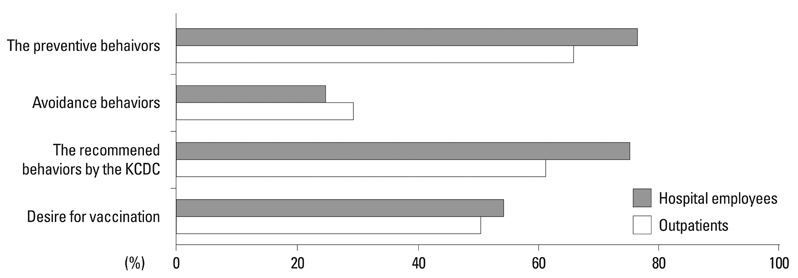Yonsei Med J.
2011 Jan;52(1):181-187. 10.3349/ymj.2011.52.1.181.
Perception and Performance of Preventive Behaviors for the Pandemic Influenza in Hospital Employees and Outpatients
- Affiliations
-
- 1Department of Family Medicine, School of Medicine, Dongguk University, Gyeongju, Korea. hweesoo@yahoo.co.kr
- 2Department of Family Medicine, School of Medicine, Kyungpook National University, Deagu, Korea.
- 3Department of Family Medicine, School of Medicine, Keimyung University, Deagu, Korea.
- KMID: 1106454
- DOI: http://doi.org/10.3349/ymj.2011.52.1.181
Abstract
- PURPOSE
A new strain of the H1N1 subtype of influenza A virus resulted in a pandemic outbreak. In South Korea, cases of pandemic influenza have increased. Therefore, we explored perception or preventive behaviors for this virus in hospital employees and outpatients.
MATERIALS AND METHODS
Data was collected from hospital employees and outpatients at three university hospitals located in Daegu, Gyeongju in South Korea between the 21st and 30th of September, 2009 using a self-administrated questionnaire. We estimated perception by components of The Health Belief Model (HBM), preventive behaviors consisted of avoidance behaviors, and the recommended behaviors by the Korea Center of Disease Control and Prevention (KCDC). Desire for vaccination was identified.
RESULTS
The 1,837 participants comprised hospital employees (n = 880, 47.9%) and outpatients (n = 957, 52.1%). Of all hospital employees, 491 (55.8%) and 708 (80.5%) perceived susceptibility of the pandemic influenza and benefits of the preventive behaviors, respectively. Among all outpatients, 490 (51.2%) and 651 (68.0%) perceived susceptibility of the pandemic influenza and benefits of the preventive behaviors, respectively. Recommended preventative behaviors were adopted by 674 (76.6%) of hospital employees and 631 (65.9%) of outpatients. Vaccination was desired by 479 (54.4%) of hospital employees and 484 (50.6%) of outpatients. Factors influencing preventative behaviors included gender, economic status (for hospital employees) and educational level (for outpatients). All HBM components except perception of barriers were associated with the preventive behaviors in both groups.
CONCLUSION
The majority of the surveyed hospital employees and outpatients perceived the benefits of preventive behaviors for pandemic influenza and performed them.
Keyword
MeSH Terms
Figure
Reference
-
1. World Health Organization Regional Office for Europe. accessed on October 2009. Available at http://www.euro.who.int/influenza/AH1N1/20090611_11.2. Korea Center of Disease Control and Prevention. access on October 2009. Available at http://cdc.go.kr/.3. Rubin GJ, Amlôt R, Page L, Wessely S. Public perceptions, anxiety, and behaviour change in relation to the swine flu outbreak: cross sectional telephone survey. BMJ. 2009. 339:b2651.
Article4. Seale H, McLaws ML, Heywood AE, Ward KF, Lowbridge CP, Van D, et al. The community's attitude towards swine flu and pandemic influenza. Med J Aust. 2009. 191:267–269.5. Mckenzie JF, Neifer BL, Smeltzer JL. Planning, Implementing and Evaluating health promotion program. Theories and models commonly used for health promotion intervention. 2005. Boston: Pearson education INC;156–158.6. Moon JS. A study of instrument development for health belief of Korean adults [dissertation]. 1990. Seoul: Yonsei Univ.7. World Health Organization Regional Office for Europe. access on October 2009. Available at http://www.euro.who.int/influenza/NewsEventsb.8. Lau JT, Yang X, Tsui H, Kim JH. Monitoring community responses to the SARS epidemic in Hong Kong: from day 10 to day 62. J Epidemiol Community Health. 2003. 57:864–870.
Article9. Nichol KL, Hauge M. Influenza vaccination of health care workers. Infect Control Hosp Epidemiol. 1997. 18:189–194.10. Jefferson T, Foxlee R, Del Mar C, Dooley L, Ferroni E, Hewak B, et al. Physical interventions to interrupt or reduce the spread of respiratory virues: systematic review. BMJ. 2008. 336:77–80.
Article11. Sansom GW. Emergency department personal protective equipment requirements following out-of-hospital chemical biological or radiological events in Australasia. Emerg Med Australas. 2007. 19:86–95.12. Mok E, Yeung SH, Chan MF. Prevalence of influenza vaccination and correlates of intention to be vaccinated among Hong Kong Chinese. Public Health Nurs. 2006. 23:506–515.
Article13. Hollmeyer HG, Hayden F, Poland G, Buchholz U. Influenza vaccination of health care workers in hospitals--a review of studies on attitudes and predictors. Vaccine. 2009. 27:3935–3944.
Article14. Lyn-Cook R, Halm EA, Wisnivesky JP. Determinants of adherence to influenza vaccination among inner-city adults with persistent asthma. Prim Care Respir J. 2007. 16:229–235.
Article


